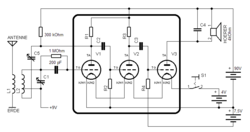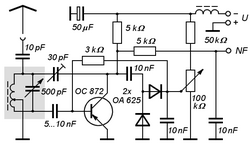1915 Kendall US1330471 Fig2
| In general, the contents of United States patents are in the public domain.
In specific cases, patent applicants and holders may claim copyright in portions of those documents. In those specific cases, applicants are required to identify the portions that are protected under copyright, and are additionally required to state the following within the body of the application and patent (see 37 CFR 1.71(d) & (e) and 37 CFR 1.84(s), and MPEP § 608.01(e) & (w) and MPEP § 1512):
The original patent should be checked for the presence of such language before an assumption is made that the contents are in the public domain. (This template can be replaced by {{PD-US-patent-no notice}} in such cases.)
|
Relevante Bilder
Relevante Artikel
AudionDas Audion ist ein Rundfunk-Geradeausempfänger und oft ein Einkreiser. Lee De Forest, der Erfinder des Audions, bildete das Wort aus dem lateinischen Wort audio, ich höre. 1907 patentierte De Forest die Audionröhre und die Audionschaltung. Ab 1909 wurde von De Forest das Audion RJ-4 verkauft. Das Verstärkerbauteil in der Audionschaltung verstärkt die empfangene Hochfrequenz und wandelt diese in hörbare Niederfrequenz um (Demodulation). Beim Rückkopplungsaudion oder Regenerativ-Empfänger wird ein Teil der verstärkten Hochfrequenz erneut dem Eingang des Verstärkerbauteils zur weiteren Verstärkung zugeführt. Das Audion war empfindlicher als der Detektorempfänger, aber weniger empfindlich als der Überlagerungsempfänger. In Deutschland waren ab 1926 das Audion OE333 und später das Rückkopplungsaudion RO433 von Loewe wegen ihres niedrigen Preises sehr erfolgreich. Später verwendeten die Volksempfänger VE301 und DKE eine Audionschaltung mit ein bis drei Röhren. Nach dem Zweiten Weltkrieg wurde in der BRD der Heinzelmann und in der DDR der 1 U11 als Audion gebaut. .. weiterlesen














